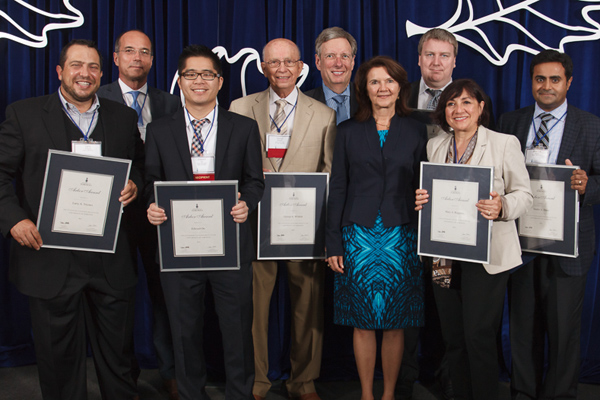
For the better part of six decades, alumnus Donald Dowds (MechE 5T3) has been giving back to U of T Engineering. As a member of multiple awards committees, the host for many student recruitment events and an organizer of the Skule Lunch & Learn speaker series, his personal service to the engineering community is exemplary.
Donald was one of 11 remarkable U of T Engineering alumni that were recognized at the 25th annual Arbor Awards on Sept.10 at The President’s Residence.
Created by U of T in 1989, the awards are presented annually to alumni and friends whose loyalty, dedication and generosity has added substantially to the quality of the University of Toronto experience.
[youtube https://www.youtube.com/watch?v=xijFEM6ZRko]
Full list of Arbor Award winners from U of T Engineering:
Paul Andersen (CompE 9T9)
Paul has volunteered at Hart House Theatre since 2001, overseeing the theatre’s transition to online ticket sales in the early 2000s. Without his leadership and expertise, Hart House Theatre would not have served its audiences so well over the past 12 years.
Shahir A. Daya (CompE 9T5)
Shahir has been an active member of the Alumni Mentorship Program since it was founded in 2005. He has gone above and beyond in this role by continuing to mentor students long after graduation. Recently, Shahir volunteered to become a co-chair of the mentorship program, which has flourished under his leadership. At last count, more than 90 engineering students have been paired with mentors.
Donald W. Dowds (MechE 5T3)
Donald was the president of the class of 5T3, a dedicated and enthusiastic class that embodies the spirit of “paying it forward” to future generations of U of T students through scholarships and awards. An active volunteer for more than six decades, Don has served on awards committees, hosted student recruitment events and organized the Skule Lunch & Learn series. He helped establish the Sudbury chapter of the U of T Alumni Association in the 1970s.
Constantine E. Karyannopoulos (ChemE 8T3, MASc 8T8)
Constantine has served on the Boundless Campaign Cabinet and the Department of Chemical Engineering and Applied Chemistry Board of Advisors, providing guidance on alumni engagement and strategic direction. He has served as a mentor to undergraduate and graduate students and was a co-founder of the D. Basmajian Graduate Scholarship for teaching assistants.
Edward On (CivE 0T8)
Edward’s experience as a student in the Alumni Mentorship Program was so valuable that he immediately volunteered as a mentor after graduation. Edward eventually became chair of the mentorship program. In this role he introduced novel initiatives and increased program participation. Today, he continues to offer leadership to U of T Engineering as a member of the Alumni Mentorship Program Committee.
Betty Yi-Shing Lin (MSE 0T3, MASc 0T5)
Over the last eight years, Betty has mentored materials science and engineering students through the Alumni Mentorship Program. She also served as co-chair of the steering committee for U of T Engineering’s centennial event, which culminated in a wildly successful two-day celebration in the fall of 2013. Betty’s leadership has helped to attract more than 300 community members to the centennial events. She shares her experiences with the Faculty through recruitment events, panel discussions and presentations.
Mary A. Ruggiero (EngSci 7T7, MMS MASc 7T9, PhD 8T3)
As a successful leader in the field of engineering, Mary is a champion for women in a profession historically dominated by men. Through an article in Impact magazine and a subsequent guest lecture, she has inspired female engineering students to follow their dreams. With her husband she established a scholarship for engineering science students. She has also helped plan and execute events celebrating the centenary of the Department of Materials Science & Engineering.
Larry A. Tricinci (CivE 8T8)
Larry has been an active volunteer with the Department of Civil Engineering for several years, participating in recruitment drives as well as career development sessions for prospective and current students. He is playing a pivotal role in the outreach to his class of 8T8, which will enhance the department’s relationship with alumni and increase participation in alumni events.
John H. Weber (MechE 7T9)
John is chair of the Department of Mechanical & Industrial Engineering Advisory Board. John also engages with alumni, supports board recruitment for senior volunteers and leads fundraising initiatives for the department. John is also a member of the Boundless Campaign Committee for the Faculty of Applied Science & Engineering.
George E. Wildish (MechE 5T3)
George is the representative for the mechanical engineering class of 5T3. He has been a member of the Skule Lunch & Learn Executive Committee (formerly known as the Class of 5T3 Lunch and Learn). George has volunteered for many years as a registration table host for the Skule Lunch & Learn speaker series.
Thomas D. Woods (IndE 7T5)
Tom is a 1975 graduate from industrial engineering and has been a member of the Department of Mechanical & Industrial Engineering Advisory Board since 2009. Tom assists with engagement of senior volunteers, is a financial supporter of the U of T Men’s Volleyball program and was a keynote speaker at the 2011 celebrations marking the 50th anniversary of industrial engineering.
Learn more about ways you can volunteer at your alma mater.

Two thousand metres below the surface of the Pacific Ocean, tiny bacteria survive in near-darkness by harvesting the dim light released from hydrothermal vents.
As humans increasingly look to the sun as a renewable energy source, what better model than these and other remarkably efficient organisms found in nature?
From October 8–9, a group of world experts in solar cell research are gathering at the University of Toronto to explore the question: what can plants teach humans about solar energy?
Hosted as part of the $1-million 2014 Connaught Global Challenge, the symposium, Bio-Inspired Ideas for Sustainable Energy, includes invited talks, poster sessions, industry networking and a public talk by special guest Sir Richard Friend of Cambridge University.
Led by Professor Ted Sargent (ECE), U of T Engineering’s vice dean, research, the symposium is inviting all U of T faculty and staff interested in sustainable energy to register for free.
To learn more about the event, U of T Engineering’s Sydney Goodfellow spoke with Professor Sargent:
Finding new solutions to our global energy crisis is no easy task – why is the Connaught Global Challenge symposium unique?
This symposium is exciting because great minds from around the world are converging in Toronto, and it’s a whole new combination of brainpower. These aren’t just leaders from one field, they’re from a whole range of different fields, and they’re coming here to learn from each other, to work towards a common goal.
People in the field of quantum biology and photobiology – specialists in the mechanisms underpinning photosynthesis – have been saying for a long time that we should look to nature to make our energy production more efficient, but nobody’s been asking how. At this symposium, we are coming together to learn from each other. Our goal is to see projects and partnerships emerge from it that will lead to further progress in solar energy – both electricity and stored fuels.
With all of these world experts converging in Toronto, could you share who at the University of Toronto and across the city may benefit from attending?
The symposium is very inclusive. Many of the attendees will be engineering and science graduate students, but it’s open across campus and appeals to a number of different fields. The more people who join from different academic and professional backgrounds the better, from physicists to materials scientists to political and environmental science students interested in energy policy.
Part of the symposium is a public lecture with Sir Richard Friend. Who is Sir Friend and what can we expect from his lecture?
[Sir Richard Friend] is a pioneer in plastic electronics, or flexible electronics. He’s had a tremendous amount of global success with turning flexible plastic materials into active devices for displays, lasing, and energy conversion.
Sparked by the ideas of photobiologists, Richard says in the abstract for his lecture that, when it comes to solar energy, nature has us beat every time: they reproduce and propagate naturally with only the power of the sun; they’re extremely efficient at using a broad spectrum of light and they remove carbon dioxide from the air in the process.
He is both inspiring and inspired by the general thrust of the symposium. We invited him to think big, to lay out the vision for the next few decades of energy generation, in particular in the role of renewable resources and natural energy production.
What are the intended outcomes of this conference?
We seek to spark a new field. This symposium is, at its core, a conversation between some of the world’s energy leaders, and the next stage will be to begin collaboration across traditional [research] boundaries to solve problems together. When the conference is done, we’ll set to work towards these goals – advances in clean energy technology that are crucial to society’s future.
In my research group, we create solar cells based on plastic flexible spray coating. We make cells that are particularly good at absorbing more of the sun’s spectrum, from the visible into the infrared. We get our inspiration from nature, because nature is great at harvesting the full rainbow spectrum of sun. Algae, for example, stack themselves in layers – a green layer, a blue layer, and so on – until they make up the full spectrum. They’re extremely efficient in handling the sun’s broad spectrum, and we gain inspiration and learn from them.
In addition, we work with soft materials that you spray down as a coating. But because they’re soft, they have all sorts of imperfections. This makes it hard for electrons to travel across their surface, but plants have these same imperfections and they transport energy very well. We’re trying to improve our electron transport abilities by looking at how nature does it. We’re also looking into antenna technology, modeling again off of plants, which will increase the rate at which our materials are able to absorb light.
Learn more about the Connaught Global Challenge Symposium: Bio-Inspired Ideas for Sustainable Energy.

The time has never been better to be an entrepreneur at the University of Toronto.
Yesterday, U of T announced that it will receive more than $3 million in funding from the Ontario government to increase training and support for student entrepreneurship.
Offered through the Ontario’s new Campus-Linked Accelerator Program (CLA), the $3,056,000 of funding over two years will enable U of T to better coordinate its entrepreneurship activities, expand the base of students exposed to entrepreneurship at the university and enhance the quality of training, said Scott Mabury, U of T’s vice-president of university operations.
“The University of Toronto has long been a leader in fostering entrepreneurship,” Mabury said. “This new investment allows us to strengthen the impact of our range of initiatives and intensify our ties with the regional innovation ecosystem.”
In fact, U of T produces more startups than any other university in Canada and is already home to a diverse ecosystem of entrepreneurship supports, including accelerators, programs, courses, classes and co-curricular organizations.
One such accelerator, U of T Engineering’s Entrepreneurship Hatchery, has nurtured successful startups like FuelWear and Modly, and engages students through speaker series, idea markets, weekend competitions, expert mentorship, access to the Faculty’s resources and more.
“I am excited about the opportunities this funding will create for the Hatchery and future participants,” said Joseph Orozco, the Hatchery’s executive director. “The Hatchery aims to change the mindset of our students, to foster merit and passion, while learning core business principles. They will leave our program with key competencies that will help them shape their own careers, and have also pushed some great ideas forward.”
The Hatchery works in tandem with other accelerators on campus and around Toronto, including Rotman’s Creative Destruction Lab, the Impact Centre in the Faculty of Arts & Science, the MaRS centre and UTEST, part of the Innovations and Partnerships office. U of T’s Banting and Best Centre for Innovation and Entrepreneurship will operate as an umbrella accelerator to coordinate entrepreneurship activities across the University’s three campuses.
“Fostering the entrepreneurial spirit among students is a key component of Ontario’s Youth Jobs Strategy, through programs that help transfer their ideas and skills to the marketplace while creating rewarding careers,” said Reza Moridi, Ontario’s minister of research and innovation and minister of training, colleges and universities.
“By partnering with colleges and universities to support entrepreneurship, we are ensuring our province’s business leaders of tomorrow are getting the support they need to succeed today.”
Read more about entrepreneurship at U of T Engineering.
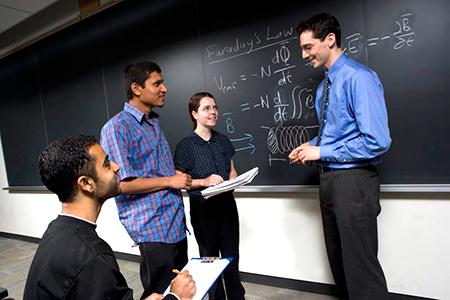
He pioneered U of T Engineering’s “inverted classroom”, was one of the first in the Faculty to teach entirely using a tablet PC, and he calls himself “a facilitator of experiences, not a deliverer of content.”
Dr. Micah Stickel (ECE), a senior lecturer in The Edward S. Rogers Sr. Department of Electrical & Computer Engineering, was named to the American Society for Engineering Education’s Top 20 Under 40 last week. The list is the cover story for the current issue of ASEE Prism, the society’s magazine.
Stickel was cited for his experience-based teaching approach, and his pioneering of the “inverted classroom” style in the Faculty of Applied Science & Engineering, where he has served as first year chair since 2012. He has won four departmental teaching awards and the Faculty’s Early Career Teaching Award.
He was also one of the first in the Faculty to teach entirely with a tablet PC, replacing the blackboard with annotations on the tablet, and he has published three papers assessing the tablet’s effectiveness as a teaching tool. One of these, “Lessons Learned From the First-Time Use of Tablet PCs in the Classroom” resulted in his selection as a New Faculty Fellow at the 38th Annual Frontiers in Education Conference in 2008.
From the Prism article:
Micah Stickel vividly recalls the lab where, as an electrical engineering undergraduate, he suddenly saw how all those theoretical ideas from class “were actually being put into practice.” Today, the University of Toronto senior lecturer pioneers high-tech and hands-on techniques to give every student such aha! moments from day one.
“I’m a facilitator of experiences, not a deliverer of content,” explains Stickel, who shunned the tenure track for teaching when he joined the faculty in 2007 after earning a Ph.D. from Toronto. His innovations have been evolving since he was a TA. To motivate and help passive learners with often-conceptual material, he introduced clickers, online quizzes that targeted misconceptions, and activities that provide instant feedback in large lectures. “It’s amazing how the class as a whole moves to the right answer,” says Stickel, who sees correct response rates jump from 50 to 80 percent after students think and talk about the problem. [Read the complete article – PDF]
“We are very proud to have teachers such as Micah who are committed to reimagining engineering education,” said Professor Faird Najm, chair of ECE. “The enthusiasm he brings to the classroom is obvious to his students, and it’s wonderful to see his excellent work recognized in this way.”
Prism is the flagship publication of the American Society for Engineering Education, a non-profit association of more than 12,000 engineering faculty members, U.S. colleges of engineering and engineering technology, corporations, and other organizations dedicated to promoting excellence in engineering and engineering technology education. Dr. Stickel serves as the University of Toronto’s representative to the ASEE.

Standing in front of 1,254 students on the first day of their engineering undergraduate careers, alumnus entrepreneur Mike Branch (ECE 0T3) declared, “You’re at the start of something incredible right now… you’re in the exact right place at the exact right time.”
On September 4, the Faculty welcomed this year’s incoming class with a special plenary lecture from Branch at Convocation Hall – from the same stage students would cross at their own graduations four or five years from now.
“Students, today is the beginning of a new journey,” said Dean Cristina Amon in her opening remarks. “Today is your first day at the finest engineering school in Canada and one of the very best in the world.”
“This journey will not always be easy,” she shared, “but you did not decide to study engineering at the University of Toronto because it was easy – you came seeking a challenge.”
The theme of challenging yourself and pushing boundaries echoed in Branch’s address, as he encouraged students to continually try new things and reach beyond expectation.
“As aspiring engineers, my biggest advice to you is to challenge yourself,” said Branch, “not just in the classroom, but in everything you do in life. When you do, you’ll inevitably open yourself to more opportunities, and therefore more chances for success.”
Branch, who started as a U of T engineering undergraduate just 15 years ago, knows all too well how it feels to sit in the seats of Convocation Hall. Now, a little over a decade after graduation, he is the founder of two successful software companies, Inovex Inc. and MapsBI.
His first company, Inovex Inc., is a software firm that Branch started in his parents’ living room shortly after graduating from U of T Engineering. The firm specializes in developing software applications for the health care, energy and environmental sectors.
With the success of Inovex, Branch and his team started MapsBI, an award-winning cloud-based software that uses mapping technology and business intelligence to interpret geographical data for a number of applications, such as analyzing the correlation between obesity rates and proximity to fast-food restaurants.
As an engineer who’s experienced a great deal of success in entrepreneurial ventures, Branch encouraged students to seek their own passions, whatever they may be.
He asked students to think deeply about why they had decided to pursue engineering, and invited them to respond using the hashtag #engineerbecause. Responses were shown on a projector via live feed. Many students agreed it was with the intention of making a positive difference on the world.
https://twitter.com/brandon_lista/status/507530222808625153
#EngineerBecause …I saw problems around me and I wanted to solve them.
— Jason Bazylak (@ProfBazylak) September 4, 2014
#engineerbecause I like it so I'm gonna put a ring on it
— Padmanie (@PadmanieAnn) September 4, 2014
“For me, it was the feeling I got when I created something,” said Branch. “I like to think that maybe some of you are here for the same reason… bringing your imagination to life.”
With a series of achievements under his belt already, Branch has no plans of slowing down. He challenged new undergraduates to follow opportunities, to innovate and to have a positive influence.
“I challenge you to take what you learn here and do something game changing with it,” he said. “Create something that will make a difference.”
Watch Branch’s plenary address:
[youtube https://www.youtube.com/watch?v=oVeDf5bhZtM]
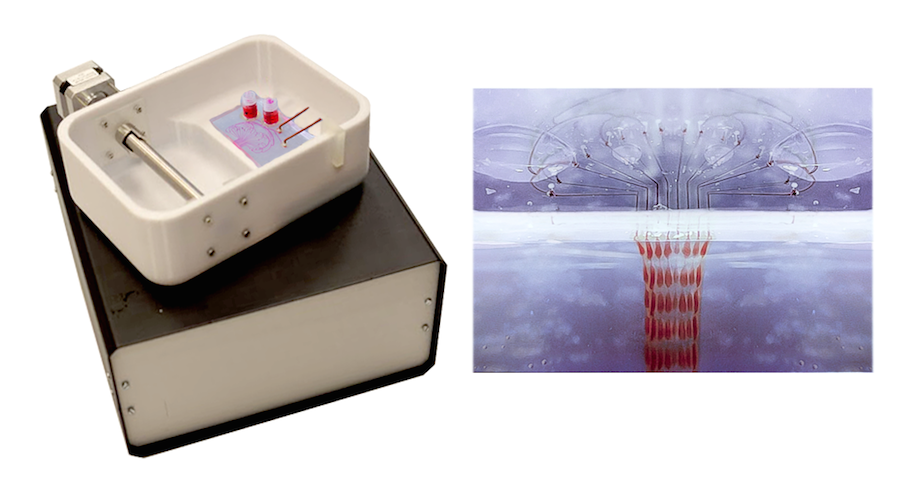
While some of us are using the new power of 3D printers to make smartphone cases and chocolate figurines, two engineering students from the University of Toronto are using them to print functional human skin.
On September 18, Arianna McAllister (IBBME MASc 1T4) and Lian Leng (MIE MASc 1T0, PhD 1T5) were named the Canadian winners of the 2014 James Dyson Award for their invention, the PrintAlive Bioprinter.
The machine – created in collaboration with Professor Axel Guenther (MIE), alumnus Boyang Zhang (ChemE PhD 1T4) and Dr. Marc Jeschke, head of Sunnybrook Hospital’s Ross Tilley Burn Centre – prints large, continuous layers of tissue that recreate natural skin.
With serious burn victims, doctors typically must remove part of the patients healthy skin and graft it onto the burned area. With PrintAlive, this painful step could be eliminated. The printed product includes hair follicles, sweat glands and other human skin complexities, providing an on-demand skin graft for burn victims.
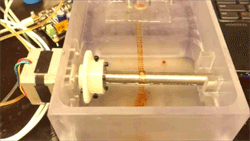 Better yet, the machine uses the patient’s own cells, which McAllister said, “would completely eliminate immunologic rejection, and the need for painful autografting and tissue donation.”
Better yet, the machine uses the patient’s own cells, which McAllister said, “would completely eliminate immunologic rejection, and the need for painful autografting and tissue donation.”
No larger than an average microwave, it’s also portable and can print skin grafts on the go, potentially revolutionizing burn care in rural and developing areas around the world.
“Ninety per cent of burns occur in low and middle income countries, with greater mortality and morbidity due to poorly-equipped health care systems and inadequate access to burn care facilities,” said Dr. Jeschke. “Regenerating skin using a patient’s own stem cells can significantly decrease the risk of death in developing countries.”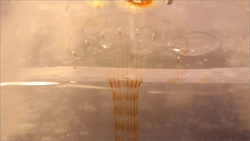
Since 2008, the team has developed hundreds of design iterations to optimize how the machine operates. Recently completing a second generation, pre-commercial prototype of the machine, they hope to scale up their device from its current bench-top process to a higher volume automated process.
Winning $3,500 in this leg of the competition, the duo now competes for the international James Dyson Award, which offers a prize of over $60,000 to inventors and their university, to be announced this November. The award was created by vacuum tycoon James Dyson to inspire students around the world to “design something that solves a problem”.
Read more about Canada’s winning team on CBC News and BBC News.
